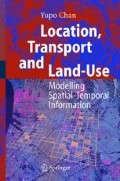This chapter borrows heavily from Yi and Chan (1988).
Access this chapter
Tax calculation will be finalised at checkout
Purchases are for personal use only
Preview
Unable to display preview. Download preview PDF.
References
Allen, P. M; Sanglier, M. (1979). "A dynamic model of growth in a central place system." Geographical Analysis, Vol 11, pp. 226–272.
Andersson, A. E.; Kuenne, R. E. (1986). "Regional economic dynamics." in Handbook of Regional and Urban Economics, Vol. I, (P. Nijkamp-Editor), Elsevier Science Publishers B.V., Amsterdam, Netherlands.
Bazarraa, M. S.; Shetty, C. M. (1979). Nonlinear Programming: Theory and Algorithms, John Wiley, New York, New York.
Belenky, A. S. (1998). Operations Research in Transportation Systems, Kluwer Acadmic Publishers, Norwell, Massaschusetts.
Bertuglia, C. S.; Leonardi, G.; Occelli, S.; Rabino, G. A.; Tadei, R.; Wilson, A. G.—Editors (1987). Urban Systems: Contemporary Approaches to Modelling, Croom Helm, Beckenham, United Kingdom.
Brown, S. (1992). "The wheel of retail gravitation." Environment and Planning A, Vol. 24, pp. 1409–1429.
Chan, Y. (2000). Location Theory and Decision Analysis, Thomson/South-Western, Cincinnati, Ohio.
Chan, Y.; Yi, P. (1987). "Bifurcation and disaggregation in urban/regional spatial modelling: a technical note." European Journal of Operational Research, Vol. 30, pp. 321–326.
Clarke, M; Wilson, A. G. (1983). "The dynamics of urban spatial structure: problems and progress." Journal of Regional Science, Vol. 23, pp. 1–18.
Dendrinos, D. S.; Sonis, M. (1990). Chaos and Socio-Spatial Dynamics, Springer-Verlag, New York, New York.
Dendrinos, D. S.; Mulally, H. (1985). Urban Evolution: Studies in the Mathematical Ecology of Cities, Oxford University Press, Oxford, United Kingdom.
Eaton, B. C; Lipsey, R. G. (1975). "The non-uniqueness of equilibrium in Loschan location model." The American Economic Review, Vol. 66, pp. 77–93.
Feichtinger, G. (1996). "Chaos theory in Operations Research." International Transactions in Operations Research, Vol 3, pp. 23–36.
Fischer, M. M.; Nijkamp, P.; Papageorgiou, Y. Y.—Editors (1990). Spatial Choices and Processes, North Holland/Elsevier Science Publishers B.V., Amsterdam, Netherlands.
Golan, A.; Vogel, S. J. (1998). "Estimation of non-stationary social accouting matrix coefficints with supply-side information." Working paper, Deparment of Economics, American University, Washingon, D.C.
Hakimi, S. L. (1990). "Locations with spatial interactions: competitive locations and games." in Discrete Location Theory (P. B. Mirchandani and R. L. Francis-Editors), Wiley-Interscience, New York, New York.
Hof, J.; Bevers, M. (1998). Spatial Optimization for Managed Ecosystems, Columbia University Press, New York, New York.
Iooss, G.; Joseph, D. D. (1990). Elementary Stability and Bifurcation Theory, Second Edition, Springer-Verlag, New York, New York.
Lorenz, E.N. (1983). "Deterministic nonperiodic flow." Journal of the Atmospheric Sciences, Vol. 82, No. 2, pp. 130–141.
Lorenz, H.W. (1993). Nonlinear Dynamical Economics and Chaotic Motion, Second Edition, Springer-Verlag, Berlin, Germany.
Manheim, M. (1984). Fundamentals of Transportation Systems Analysis — Volume 1: Basic Concepts, MIT Press, Cambridge, Massachusetts.
May, R. (1976). "Simple mathematical models with very complicated dynamics." Nature, Vol 261, pp. 459–467.
Miyao, T. (1987). "Dynamic urban models." chapter 22 in Handbook of Regional and Urban Economics, Vol II (E S. Mills—Editor), Elsevier Science Publishers B.V., Amsterdam, Netherlands.
Moon, F. C. (1992). Chaotic and Fractal Dynamics, Wiley-Interscience, New York, New York.
Nijkamp, P.; Reggiani, A. (1992). Interaction, Evolution and Chaos in Space, Springer-Verlag, Berlin, Germany.
Nijkamp, P.; Reggiani, P. (1993). "Stability and complexity in spatial Networks." Discussion paper TI93-249, Tinbergen Institute, Amsterdam-Rotterdam, the Netherlands.
Noble, B. (1969). Applied Linear Algebra, Prentice Hall, Englewood, New Jersey.
Puu, T. (1997). Mathematical Location and Land Use Theory: An Introduction, Springer-Verlag, Berlin, Germany.
Sen, A.; Smith, T. (1995). Gravity Model of Spatial Interaction Behavior, Springer-Verlag, Berlin, Germany.
Silberberg, E. (1990). The Structure of Economics: A Mathematical Analysis, Second Edition, McGraw-Hill, New York, New York.
Smith, B. A. (1996). Private communication.
Upton, G. J. G.; Fingleton, B. (1989). Spatial Data Analysis by Example: Categorical and Directional Data—Volume 2, Wiley, Chichester, United Kingdom.
Webber, M. (1984). Prediction, Explanation, and Planning: the Lowry Model, Research in Planning and Design, Volume 11, Pion, London, United Kingdom.
Wilson, A. G. (1981). Catastrophe theory and bifurcation: applications to urban and regional systems, Croon Helm, Beckenham, United Kingdom; and University of California Press, Berkeley, California.
Wong, C. K.; Wong, S. C; Tong, C. O. (1998). "A new methodology for calibrating the Lowry Model." Journal of Urban Planning and Development, Vol. 124, No. 2, pp. 72–91.
Yi, P.; Chan, Y. (1988). "Bifurcation and disaggregation in Lowry-Garin derivative models: theory, calibration, and case study." Environment and Planning A, Vol. 20, pp. 1253–1267.
Yi, P. (1986). "Infrastructure Management: a Bifurcation Model in Urban Regional Planning." Master's thesis, Department of Civil and Environmental Engineering, Washington State University, Pullman, Washington.
Rights and permissions
Copyright information
© 2005 Springer-Verlag Berlin Heidelberg
About this chapter
Cite this chapter
(2005). Chaos, Catastrophe, Bifurcation and Disaggregation in Locational Models. In: Location, Transport and Land-Use. Springer, Berlin, Heidelberg. https://doi.org/10.1007/3-540-26851-0_7
Download citation
DOI: https://doi.org/10.1007/3-540-26851-0_7
Publisher Name: Springer, Berlin, Heidelberg
Print ISBN: 978-3-540-21087-0
Online ISBN: 978-3-540-26851-2
eBook Packages: EngineeringEngineering (R0)

